AMD Ryzen 7 8700G and Ryzen 5 8600G Review: Zen 4 APUs with RDNA3 Graphics
by Gavin Bonshor on January 29, 2024 9:00 AM EST- Posted in
- CPUs
- AMD
- APUs
- Phoenix
- 4nm
- Zen 4
- RDNA3
- AM5
- Ryzen 8000G
- Ryzen 7 8700G
- Ryzen 5 8600G
iGPU Gaming Performance: 1080p
There are limitations with integrated graphics, even those on the latest APUs, such as the AMD Ryzen 7 8700G with Radeon RDNA3-based graphics. That being said, we have tested our new suite of games for 2024 in this review, at least at 1080p on the integrated graphics. As we expand into 2024, we'll be benching all our CPUs on the new titles in our list, including the latest F1 2023, Returnal, the updated Cyberpunk 2077, and the demanding Company of Heroes 3 RTS.
We are using DDR5-5200 memory as per the JEDEC specifications on the Ryzen 7 8700G and Ryzen 5 8600G, as well as DDR4-3200 on the Ryzen 7 5700G and Ryzen 5 5600G. The same methodology is also used for the AMD Ryzen 7000 series and Intel's 14th, 13th, and 12th Gen processors. Below are the settings we have used for each platform:
- DDR5-5200 CL44 - Ryzen 8000G
- DDR4-3200 CL22 - Ryzen 5000G
- DDR5-5600B CL46 - Intel 14th & 13th Gen
- DDR5-5200 CL44 - Ryzen 7000
- DDR5-4800 (B) CL40 - Intel 12th Gen
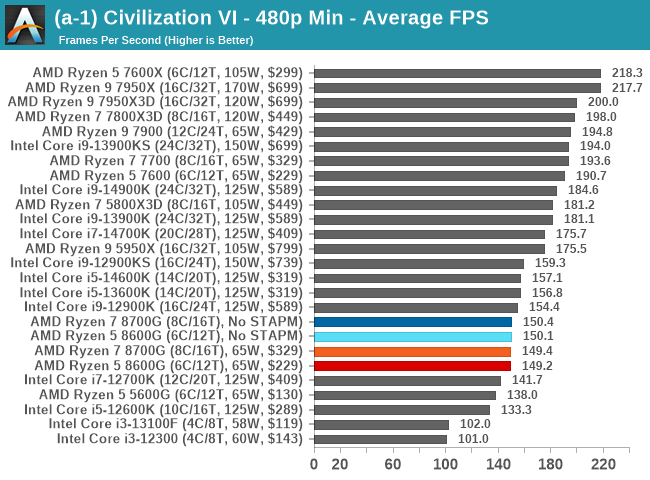
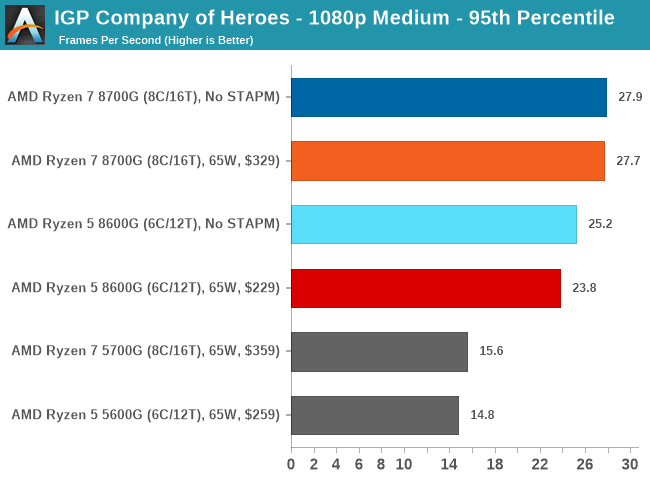
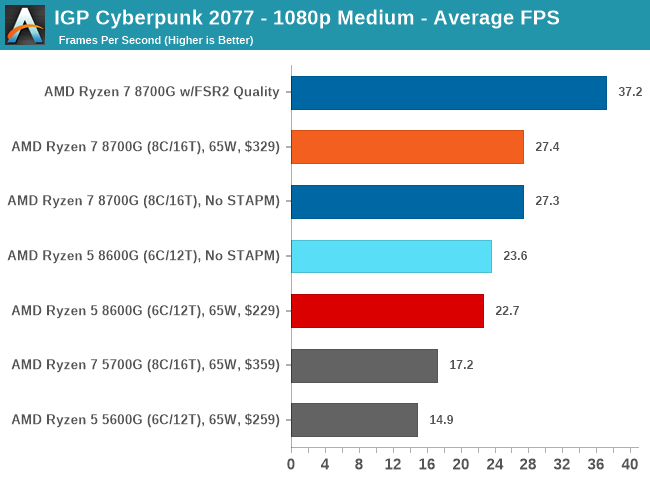

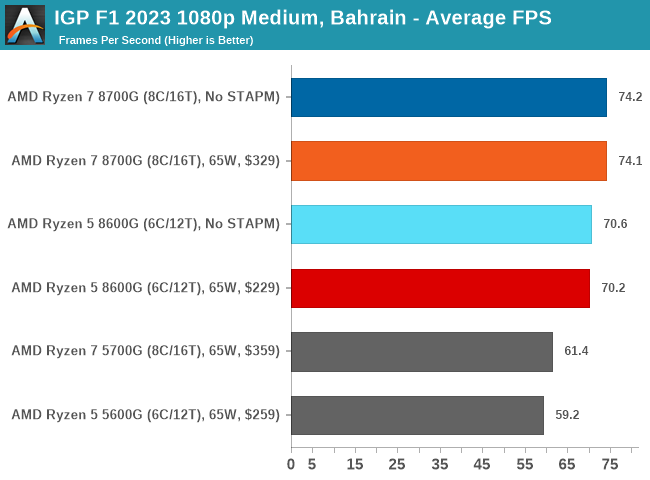

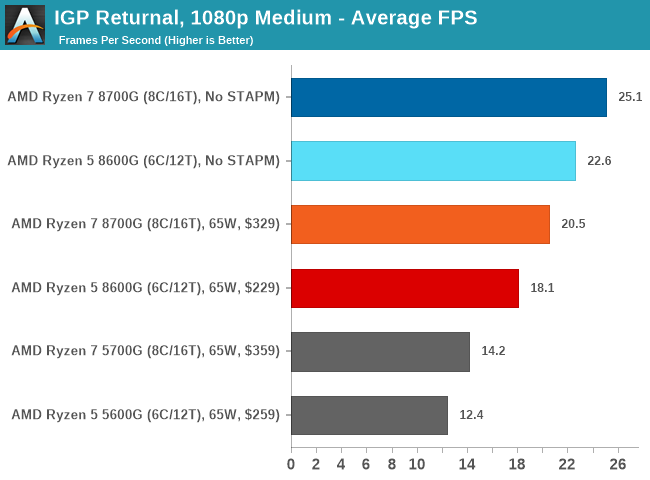
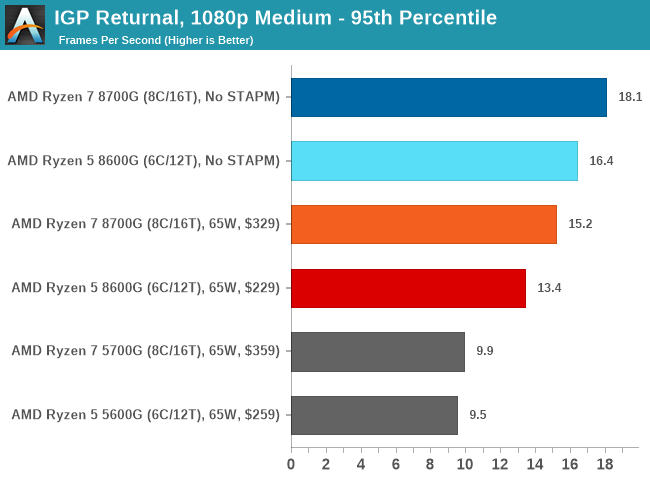
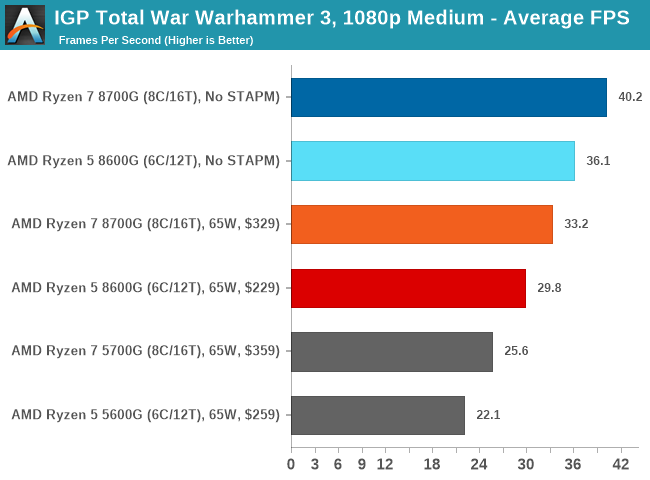

Using the new games in our test suite to compare performance between the Ryzen 8000G and Ryzen 5000G APUs, we can see a stark difference in gaming performance between the two generations of APUs. Firstly, the Ryzen 7 8700G is consistently ahead when using Medium settings at 1080p than the Ryzen 7 5700G, while the Ryzen 8600G is also comfortably ahead of both Ryzen 5000G APUs.
To add a little variation, we also tested Cyberpunk 2077 with AMD's FidelityFX image quality toolkit and saw fantastic performance. Not only did we see an uplift of around 37% in performance between the Ryzen 7 8700G and Ryzen 7 5700G, but with AMD FidelityFX applied, we saw an uplift of over 53%, which is impressive. Of course, not every game or title has FidelityFX, but applying it can certainly improve framerate performance with AMD's Ryzen 8000G series APUs.
Retesting the latest firmware, we can see that the Ryzen 7 8700G and Ryzen 5 8600G performance is marginally better at 1080p, just as we experienced at 720p on the Radeon 700M series integrated graphics. Gaming benchmarks are that they typically don't represent sustained loads, and we expect these performance figures to be sustained over longer periods of time with STAPM limitations removed.










111 Comments
View All Comments
TheinsanegamerN - Tuesday, January 30, 2024 - link
guys WHY would you use a CPU only test in a CPU REVIEW??!?!?!?t.s - Tuesday, January 30, 2024 - link
Cause it have best iGPU in its class. If you won't test that, why bother testing, as it's almost certain that 7700x or 7700 will be better.AndrewJacksonZA - Tuesday, January 30, 2024 - link
👍TheinsanegamerN - Wednesday, January 31, 2024 - link
Ok, and in the CPU bench section they use a CPU test. How would you know if a 7700 would be better in CPU load if you dont test it?AndrewJacksonZA - Tuesday, January 30, 2024 - link
guys WHY would you only test PART of a CPU in a CPU REVIEW??!?!?!?TheinsanegamerN - Wednesday, January 31, 2024 - link
How DARE we want to see what a CPU does in a CPU review. WAAAH I NEED IGPU OR ILL CRY WAAAAHFWhitTrampoline - Tuesday, January 30, 2024 - link
Because AMD does not support ROCm/HIP for its iGPUs and its ROCm/HIP for consumer dGPUs is lacking as well on Linux. And the Blender Foundation starting with Blender 3.0/Later editions has dropped supporting OpenCL as the GPU compute API. And so since Blender 3.0/later the Blender Foundation only supports Nvidia's CUDA for non Apple PCs/Laptops and Apple's Metal for Apple silicon for Blender 3D 3.0/later editions.So without any Ryzen iGPU support for ROCm/HIP there's nothing to take the CUDA Intermediate Language Representation(ILR) and convert that to a form that can be executed on Radeon iGPU/dGPU hardware. And for Intel's iGPUs and dGPUs it's Intel's OneAPI/Level-0 that does the translating of the CUDA ILR to a form than can be executed on Intel's iGPU/dGPU hardware and for Intel that OneAPI/Level-0 works for Windows and Linux!
Blender 3D generates CUDA PTX ILR and All GPU Makers us Intermediate Languages for GPUs so GPU makers/others ship no pre-compiled binaries where software gets directly compiled into the GPUs Native Instruction Set in advance. And that's so the ILR code remains portable across OS/Ecosystems and GPU makers are free to modify their GPU ISA and still maintain comparability with software that only gets compiled into a portable Intermediate language Representation(ILR)
FWhitTrampoline - Tuesday, January 30, 2024 - link
Edit: maintain comparabilityto: maintain compatibility
I hate Firefox's Spell Checker its a Train Wreck as always!
thestryker - Monday, January 29, 2024 - link
Feels like these APUs deserve a DRAM scaling article comparing the IGP performance.GeoffreyA - Tuesday, January 30, 2024 - link
Yes, that would be a nice one. Always necessary for APUs.